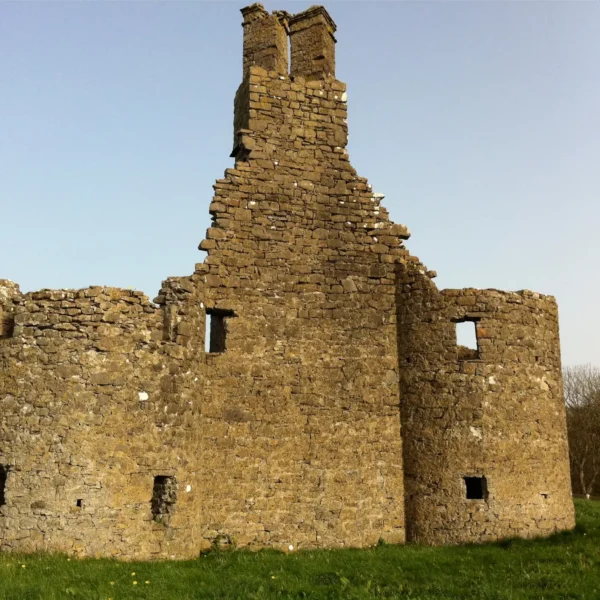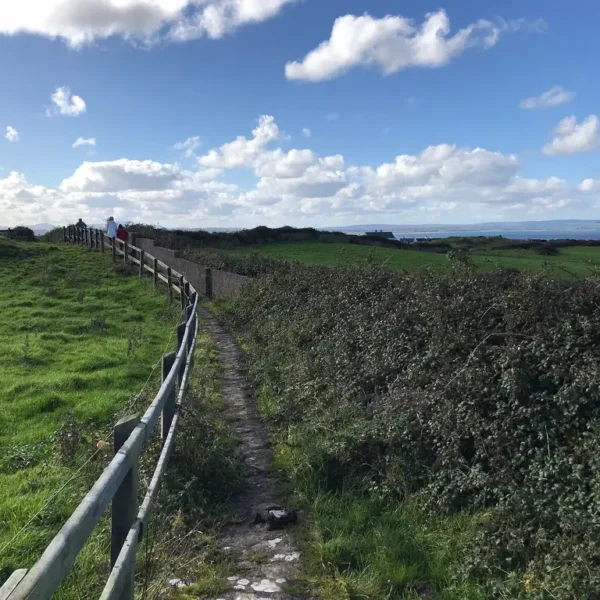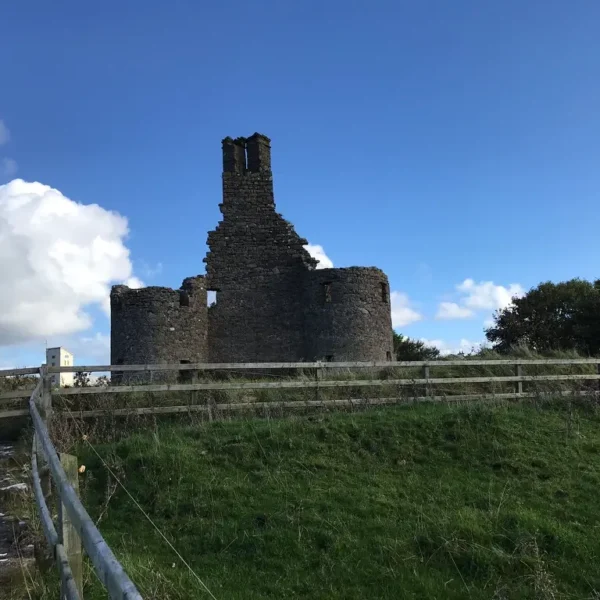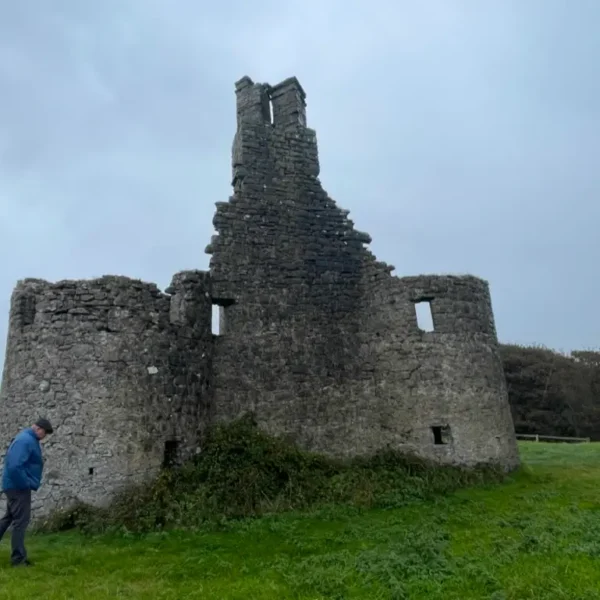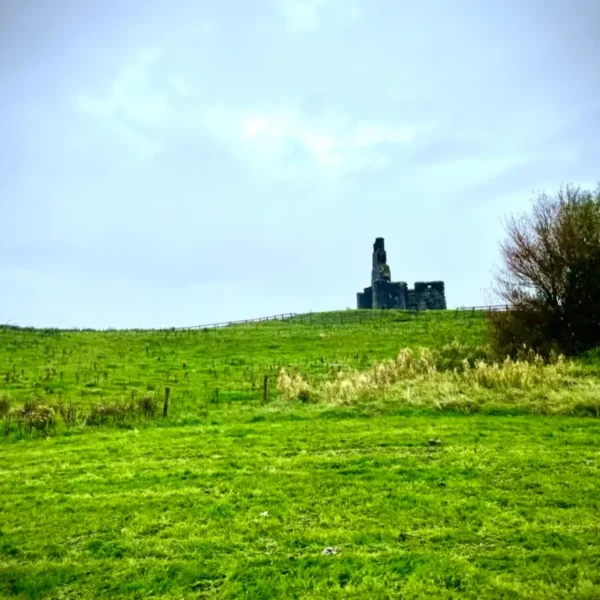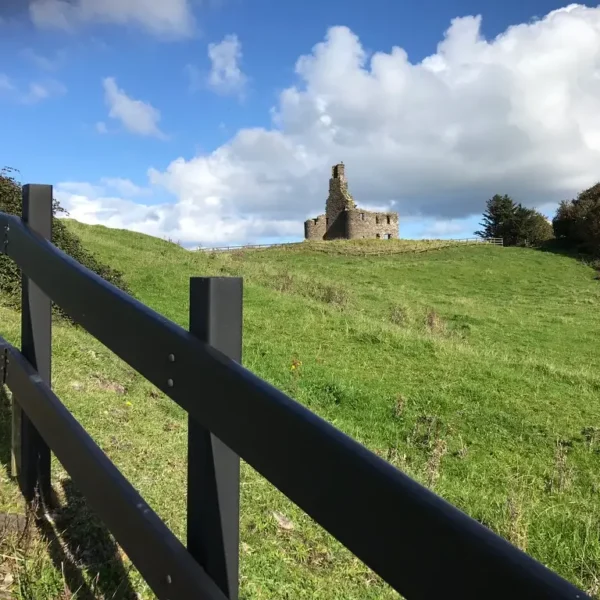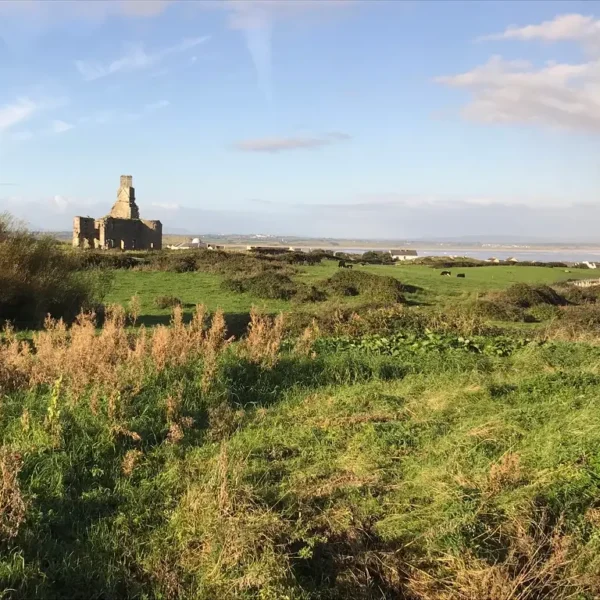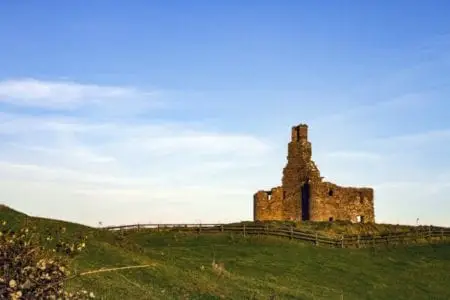Enniscrone Castle
January 21, 2025 2025-07-10 3:29Enniscrone Castle
Enniscrone Castle
A Stronghold of the O’Dubhda Clan
Enniscrone Castle, a proud sentinel overlooking the wild Atlantic coast in County Sligo, stands as a powerful testament to the enduring legacy of the O’Dubhda (also known as O’Dowd, Ó Dubhda, O’Dowda, and Dowd) clan. For centuries, this strategic stronghold was intertwined with the destiny of the O’Dubhda ancestors, the hereditary keepers of the western seaways. Though time and conflict have left their mark, the ruins of Enniscrone Castle continue to whisper tales of Gaelic power, resilience, and a deep connection to the land and sea, inviting exploration into the rich tapestry of this shared history.
I. Overview: Journey Through Time at Enniscrone Castle
Enniscrone Castle, known by various local names such as Field Castle, O’Dowd’s Castle, or Nolan’s Castle, occupies a strategically commanding position on an elevated ridge to the northeast of Enniscrone town in County Sligo, along Ireland’s Wild Atlantic Way. This location highlights its historical significance as a crucial point along an ancient coastal route that connected Connacht to west Ulster. This site has been a focal point of human activity for millennia, with archaeological remains in the surrounding Castle Field dating back to the megalithic age, including possible passage tombs from approximately 2500 BC (or even 5500 BC according to some accounts) and a ring fort from between 500 and 1000 AD.
The history of Enniscrone Castle itself is layered and complex. The first fortification on this site dates back to the late 14th century, erected by the O’Dubhda clan, a powerful Gaelic family who ruled over much of the Tireragh region. The ruins visible today, however, primarily represent a later structure: an early 17th-century semi-fortified house, built upon the foundations of the earlier O’Dubhda stronghold after periods of destruction and changing ownership. This distinction is crucial for understanding the castle’s narrative. The original O’Dubhda fortification was likely a more purely defensive structure, characteristic of Gaelic power, while the later “Nolan’s Castle” was a “semi-fortified house” or “stronghouse” designed for both comfort and defense. This architectural evolution reflects broader historical trends in Ireland, where purely defensive castles became less effective against advancements in artillery, leading to a focus on fortified residences that balanced security with domesticity. The O’Dubhda’s initial construction signifies their raw power and strategic control, while the later iteration by Anglo-Irish settlers points to a more settled, albeit still volatile, colonial landscape. Acknowledging that the current ruins are not the exact physical manifestation of the O’Dubhda’s 14th-century stronghold, but rather a successor built on its historically significant site, adds critical nuance and accuracy to the clan’s historical narrative. This highlights their initial dominance and subsequent displacement, while still maintaining their profound connection to the site itself.
The O’Dubhda clan, known as the hereditary keepers of the western seaways, recognized the castle’s strategic importance. Its elevated position provided commanding views of the Atlantic, which was indispensable for monitoring maritime activity and defending against incursions. This strategic advantage reinforced their reputation as protectors of the coast. Beyond its defensive capabilities, Enniscrone Castle served as a significant center of power and influence for the clan, embodying their authority and control over the region. The later structure, while built by others, continued to blend defensive features with residential comfort, reflecting the evolving needs of fortified residences in a changing political landscape.
II. The Storied Past: Enniscrone Castle Through the Ages
A. Roots of Power: The O’Dubhda Clan and Early Fortifications (14th-15th Century)
The O’Dubhda (Ó Dubhda, O’Dowd, O’Dowda, Dowd) clan boasts an ancient and distinguished lineage. Their descent is traced from Fiachrae, an older half-brother of Niall of the Nine Hostages, through Nath Í mac Fiachrach (also known as Dathí), the last pagan High King of Ireland. This makes the O’Dubhda surname one of the oldest continuously used family names in Europe, with its first recorded mention in 982 AD, when Aedh Ua Dubhda, King of Connacht, “died an untroubled death”. For centuries, the O’Dubhda ancestors were the leading sept of the northern Uí Fiachrach, a tribal group that held sway over what are now County Mayo and County Sligo, and provided successive kings of Connacht.
The O’Dubhda’s power was considerable, described as a “maritime power of considerable ability” in the 12th and 13th centuries. They demonstrated remarkable resilience in holding their territory intact against formidable forces such as the Burkes and Birminghams. To secure their kingdom in Uí Fiachrach Muaidhe (Northwest Connacht), the O’Dubhda’s strategically fortified their lands with a formidable network of “20 castles,” often referred to as “10-Pound Castles”. This extensive network was the backbone of their enduring power despite external pressures like Anglo-Norman incursions. Enniscrone Castle was not an isolated defensive structure but an integral component of this larger, meticulously planned defensive system. This system was fundamental to the O’Dubhda’s ability to maintain their sovereignty and influence in Northwest Connacht for centuries, showcasing the clan’s remarkable military acumen and strategic foresight.
The first fortification at Enniscrone was erected by the O’Dubhda’s at the close of the 14th century, establishing its early significance as a clan stronghold. A profound connection to Enniscrone is documented in the Book of Lecan, a venerable manuscript compiled between 1397 and 1418 near Enniscrone itself. This book contains a poetic creation by Giolla Iosa Mor Mac Firbis from 1417, commemorating the inauguration of Tadhg Riabhach o’Dubhda (Ó Dubhda) as chieftain of the barony of Tireragh. Tadhg Riabhach resided at Enniscrone Castle and was a notable patron of Augustinian Abbeys. This highlights the castle’s importance not just as a military site, but as a ceremonial and administrative heartland for the clan. The O’Dubhda clan is uniquely distinguished by having a detailed account of their Taoiseach (clan leader) inauguration ceremony preserved within the Great Book of Lecan, underscoring the depth of their cultural and historical traditions. This confluence of evidence strongly links Enniscrone, and particularly its castle, to the highest levels of O’Dubhda cultural, political, and intellectual life. Enniscrone Castle holds profound symbolic importance for the O’Dubhda clan, representing not only their military strength and territorial control but also their deep cultural identity, their unique leadership traditions, and their significant patronage of scholars like the MacFirbises, who preserved their history. This makes the clan’s connection to the castle far richer and more multifaceted than mere ownership.
Table 1: Key O’Dubhda Clan Leaders Associated with Enniscrone/Tireragh
Name (Alternative Spellings) | Title/Role | Key Event/Connection to Enniscrone/Tireragh | Dates |
Aedh Ua Dubhda (Hugh O’Dooda) | King of Connacht | First recorded O’Dubhda surname | d. 982 |
Sen-Bhrian O’Dowd | Clan Leader | Drove Anglo-Norman settlers out of Tireragh for a time | 1354 |
Tadhg Riabhach o’Dubhda (Ó Dubhda) | Taoiseach of Tireragh | Inaugurated at Enniscrone (1417), lived at Enniscrone Castle, patron of Augustinian Abbeys | c. 1417 (inauguration), d. 1432 |
Conor O’Dowd | Taoiseach | Built a smaller keep at Castleconner near Ballina | 1520 |
Tadhg Bui | Tanaiste (successor) | Last Taoiseach formally installed according to ancient Brehon Laws, sold Enniscrone Castle in 1596 | d. 1601 (believed) |
B. Conflicts, Sieges, and Shifting Ownership (16th-17th Century)
Despite their formidable defenses and resilience, the O’Dubhda’s power was gradually diminished by the Anglo-Norman incursions that began in the 13th century. However, the clan demonstrated remarkable strength, with figures like Sen-Bhrian O’Dowd successfully driving out Anglo-Norman settlers from Tireragh for a period in 1354.
Enniscrone Castle itself was a witness to and participant in significant conflicts, reflecting the broader historical narrative of Ireland during the medieval and early modern periods. A pivotal moment occurred in 1512 when the castle was besieged and deliberately destroyed by the O’Donnells of Tir Chonaill, who had routed the Bourkes of Tyrawley from within its walls. Following this destruction, the O’Dubhda’s bravely rebuilt the castle, but by this time, their regional power was undeniably waning.
A significant transfer of ownership occurred in 1597 when Mac Donnells, gallowglasses (mercenaries) who had served the O’Dubhda’s, sold the castle to John Crofton. The current castle structure, which stands in ruins today, was built at the end of the 16th century or early 17th century on the site of the O’Dubhda’s original fortification. John Crofton is believed to have rebuilt it in an “English style” before selling it to Thomas Nolan of Ballinrobe, Co. Mayo. This architectural shift from the O’Dubhda’s original fortification to the later “English style” or “semi-fortified house” built by subsequent owners is highly significant. This change reflects a fundamental transition from purely defensive Gaelic strongholds to structures that blended defense with residential comfort, a hallmark of the Plantation era. This evolution was driven by new military technologies, such as artillery, which rendered older, purely defensive castles increasingly obsolete, and by changing social needs, including a desire for more comfortable living arrangements. The architectural evolution of Enniscrone Castle itself tells a compelling story of adaptation and changing priorities, illustrating the transition from the O’Dubhda’s focus on raw defense to the later settlers’ blend of security and domesticity. This highlights how broader political and technological changes directly influenced local building practices and fundamentally altered the very nature and design of “castles.”
Nolan’s son was residing at the castle in 1642. During the tumultuous Confederate Wars of 1641, the Confederates seized the castle and established a garrison there. It was subsequently captured by Parliamentarian troops under the command of Sir Charles Coote in 1645. The castle then passed into the possession of Sir Francis Gore during the widespread Cromwellian confiscations of 1641-1642, marking a definitive shift in ownership away from Gaelic hands. The last formal election of an O’Dowd Taoiseach took place in 1595, by which point the clan had become a client of the O’Connor clan of Sligo. Their power experienced a rapid decline following the Irish defeat in the Nine Years War (1603). The succession of owners and the castle’s involvement in major conflicts—the O’Donnell siege, the Confederate Wars, and the Cromwellian confiscations—provide a tangible reflection of the broader historical narrative of Ireland during the medieval and early modern periods. This includes the dynamics of Gaelic clan power, intense inter-clan rivalries, the relentless process of English conquest, and the subsequent implementation of the Plantations. The castle’s transfer from O’Dubhda ownership to Anglo-Irish hands directly symbolizes the decline of indigenous Gaelic power and the ascendancy of English influence and settlement. Enniscrone Castle is far more than just a site of O’Dubhda history; it serves as a powerful, tangible representation of the profound political, social, and cultural transformations that swept across Ireland, particularly in Connacht, from the 14th to the 17th centuries. Its changing fortunes offer a compelling narrative of the turbulent times and the immense resilience required to navigate them.
Table 2: Chronology of Enniscrone Castle Ownership/Key Events
Approximate Date/Period | Owner/Controlling Entity | Key Event/Status |
Late 14th Century | O’Dubhda Clan | First fortification built by the O’Dubhda clan |
1417 | O’Dubhda Clan (Tadhg Riabhach) | Inauguration of Tadhg Riabhach o’Dubhda commemorated in Book of Lecan, lived at castle |
1512 | O’Donnells (besieging) | Castle besieged and deliberately destroyed by O’Donnells |
Post-1512 | O’Dubhda Clan | Castle rebuilt by O’Dubhda, but power waning |
1597 | John Crofton (via Mac Donnells) | Castle sold to John Crofton by O’Dubhda’s gallowglasses |
Late 16th/Early 17th Century | John Crofton / Thomas Nolan | Current castle structure built in “English style” on site of O’Dubhda castle; sold to Thomas Nolan |
1641 | Confederate Irish | Castle commandeered and garrisoned during Confederate Wars |
1645 | Parliamentarian Troops (Sir Charles Coote) | Castle captured by Parliamentarian forces |
1641-1642 (Cromwellian Confiscations) | Sir Francis Gore | Castle passed into Gore family possession |
18th Century – 1920s | Orme Family | Ownership transferred to Orme family, maintained until 1920s |
1920s | Irish State | Castle handed over to the Irish State, becoming public heritage |
C. From Private Hands to Public Heritage (18th Century to Present)
Following the Gore family’s possession, the castle passed into the hands of the Orme family, who maintained ownership until the 1920s. A significant transition occurred in the 1920s when Enniscrone Castle was officially handed over to the Irish State. This momentous event ensured its long-term preservation and secured its place as a vital part of Ireland’s national public heritage.
III. Architectural Marvels: Unveiling Enniscrone Castle’s Design
A. The O’Dubhda’s Original Stronghold (Late 14th Century)
The first fortification at Enniscrone was built by the O’Dubhda’s at the end of the 14th century. While specific architectural details of this initial structure are not extensively documented in the available records, it would have served as a crucial defensive stronghold for the clan. The O’Dubhda’s were known for their formidable network of “20 castles,” which included traditional Gaelic strongholds and adapted Norman castles, reflecting a pragmatic and effective approach to territorial defense. Early castles, often initially constructed from wood, evolved into more robust stone structures as the need for stronger defenses grew, particularly with advancements in warfare. The geometry of such castles was primarily dictated by defensive considerations, often featuring round towers to minimize vulnerable corners and maximize shooting coverage. The precise architectural form of the original O’Dubhda castle at Enniscrone remains largely unrecorded in the provided information. This presents a challenge in fully reconstructing its initial appearance and function. While the clan’s presence and ownership are clearly established, the physical manifestation of their early power at this specific site remains largely a subject for further archaeological investigation, beyond its fundamental purpose as a “stronghold.” This highlights the importance of ongoing archaeological work to potentially uncover remnants of earlier phases.
B. The 17th-Century Fortified House: A Blend of Comfort and Defense
The current ruins of Enniscrone Castle are a notable example of an early 17th-century semi-fortified house, also classified as a stronghouse or Jacobean house. This structure was erected primarily as a comfortable residence, reflecting a broader architectural shift from purely defensive medieval castles. However, it was simultaneously designed to be capable of defending against small-scale attacks, embodying a blend of domesticity and security.
The castle’s design features a rectangular gabled house with three-quarter round towers at its angles. Of these, only the two western towers remain intact today, with two others having been destroyed over the centuries. The building originally comprised two storeys with attics. Evidence of its defensive capabilities includes a main arched doorway in the north wall, where drawbar sockets are still visible. Internally, the castle featured a large, centrally placed fireplace with a small circular oven on the ground floor, and a smaller fireplace on the upper storey, with their chimneys still intact. The presence of diamond-shaped chimney stacks further dates the castle to the late 16th century.
Despite some earlier interpretations suggesting a primary focus on comfort, recent in-depth analysis indicates that defense was a significant objective in the castle’s design. This is evidenced by the presence of numerous gun loops, potentially up to thirty-two, and strategically placed large ground-floor windows that allowed for flanking fire from the corner towers. The high-quality stonework, superior to that typically found in standard stronghouses, also points to a robust defensive intent. This re-evaluation of the castle’s primary function is a crucial development in its historical understanding. While it offered comfort, its design was fundamentally driven by defensive needs, even in the 17th century. This highlights the dynamic nature of historical understanding, where even seemingly established facts can be refined by new research and technology.
C. Insights from Modern Surveys and Research
Modern archaeological techniques and scholarly research continue to unveil new layers of understanding about Enniscrone Castle and its environs. Aerial surveys, utilizing cutting-edge techniques such as LiDAR (Light Detection and Ranging), orthophotography, and digital surface models (DSM), have been conducted by researchers like Dr. Naessens. These surveys have revealed extensive archaeological wealth in the surrounding landscape, including earthworks, external defenses, ancient routeways, and a clearer picture of the castle’s natural positioning within its environment.
These aerial insights further highlight the Enniscrone castle field site’s central role in a broader local historical context, revealing nearby ringforts and probable megalithic tombs along the esker ridge. Frank J. Hall, a doctoral researcher at the University of Galway, is specifically conducting research on stronghouses and fortified houses in Connacht, with Enniscrone Castle forming a key part of his study. His work aims to define the role and architectural form of these early modern Irish stronghouses, contributing significantly to the academic understanding and conservation of these important historical structures. Hall’s recent in-depth analysis, informed by these advanced survey methods, suggests that defense was indeed the primary objective for Enniscrone Castle, a conclusion supported by the evidence of its numerous gun loops and the superior quality of its stonework compared to typical stronghouses. This ongoing scholarly engagement ensures that the interpretation of Enniscrone Castle’s past remains vibrant and responsive to new evidence.
IV. Legends and Lore: Tales from Enniscrone Castle’s Shadows
Enniscrone Castle, like many ancient sites in Ireland, is steeped in local legends and folklore, which provide a cultural lens through which to understand the O’Dubhda’s relationship with their territory. These tales, while not strictly historical, reflect the clan’s identity, their environment, and the values they held, adding a vital layer of local identity to the factual history.
A. The Mermaid of Enniscrone Castle
One popular tale, explicitly tied to an O’Dowd chieftain, tells of a beautiful mermaid discovered asleep on the rocks, her red cloak lying beside her. The O’Dowd chieftain, captivated by her beauty, took and hid her red cloak. Without her magical cloak, she was transformed from a mermaid into a woman, unable to return to the sea. The chieftain subsequently married her, and they had seven sons.
The legend continues that the mermaid made her husband promise never to go to sea again. However, he eventually broke this promise. While he was at sea, one of their sons revealed to his mother that he had seen his father looking at a beautiful red cloak. Recognizing it as her own, she retrieved it and decided to return to her true home in the ocean. Unable to bring her half-human sons with her, she tragically transformed them into seven rocks with a wave of her red cloak. These seven rocks are said to be visible in Scurmore woods (or in the sea near Enniscrone, depending on the version of the tale) and are believed to bleed every seven years if pricked. This legend vividly highlights the O’Dubhda clan’s deep connection to the sea and the mystical elements of the Irish coastline, reinforcing their historical identity as “hereditary keepers of the western seaways” and their maritime prowess.
B. The Black Pig of Muckduff
Another compelling local legend, while not directly tied to Enniscrone Castle itself, is deeply rooted in the Enniscrone area. It tells of a wild boar, said to possess magical powers and deadly poisonous bristles, that rampaged from Donegal all the way to Enniscrone, killing everything in its path. The local people, recovering from their initial fright, united to confront the beast. They eventually managed to run the Black Pig to ground in a field in Muckduff (a name derived from the Irish for “Black Pig”), where the wild creature was finally slain and buried. A sculpture of the Black Pig now stands prominently in Enniscrone, commemorating this enduring tale. This legend grounds the broader Enniscrone area in a rich mythical landscape, demonstrating the deep connection between the people, their environment, and their oral traditions.
V. Visiting Enniscrone Castle Today: A Glimpse into the Past
A. Location & Access
The atmospheric ruins of Enniscrone Castle are situated on a hill north of Enniscrone town, within the open space known as Castle Field, in County Sligo. The approximate coordinates for the castle are 54.21588, -9.08627. The site, consisting of open ruins, is generally free to explore. While some sources may indicate it is “closed”, this typically refers to managed facilities or specific buildings, as the ruins themselves are in an open field and accessible year-round, usually during daylight hours. Visitors are encouraged to respect the historical significance of the site. The best time to visit is often cited as sunset, when the castle is bathed in golden light, offering truly unforgettable views over the Atlantic.
B. What to Expect
Visitors to Enniscrone Castle can anticipate an evocative experience, walking through ancient ruins while enjoying the stunning coastal scenery that surrounds the site. The surviving western towers and remnants of walls offer a tangible glimpse into the castle’s past structure. Beyond the castle itself, the surrounding Castle Field holds significant archaeological interest, including scattered ruins of two possible passage tombs dating from approximately 2500 BC (or 5500 BC, according to some accounts) and a ring fort from between 500 and 1000 AD. The site’s inclusion as part of Ireland’s Wild Atlantic Way provides visitors with broader opportunities for exploration and discovery along this dramatic coastline.
C. Important Considerations & Current Historical Updates
When visiting Enniscrone Castle, it is advisable for visitors to wear sturdy shoes due to uneven terrain. Respect for private property and the historical significance of the site is paramount.
The story of Enniscrone Castle is not confined to the past; it is an actively unfolding narrative shaped by ongoing research and conservation efforts. Frank J. Hall, a doctoral researcher at the University of Galway, is currently engaged in significant research on stronghouses and fortified houses across Connacht, with Enniscrone Castle being a key focus. His work, which incorporates advanced aerial survey data such as LiDAR, orthophotography, and digital surface models (DSM), is yielding new perspectives on the castle’s architecture and its primary defensive purpose, challenging some older interpretations. This research is part of a broader academic effort to enhance the understanding and ensure the effective conservation of these vital historical structures.
Furthermore, Enniscrone Castle is a direct beneficiary of significant conservation investment. It has been allocated €118,671 under the Community Monuments Fund (CMF) 2025 for Phase 2 conservation works. This substantial funding is specifically earmarked to complete essential structural repairs, thereby ensuring the long-term preservation and safeguarding of this important monument for future generations. This initiative exemplifies the collaborative efforts between local communities, site custodians, and national bodies (such as Sligo County Council and the Department of Housing, Local Government and Heritage) in cherishing and caring for Ireland’s archaeological heritage. A recent update from August 2024 confirms that “RESTORATION Work has now started on Enniscrone Castle Co Sligo… the project will start 2nd week september 2024”. This aligns perfectly with the CMF funding and underscores a powerful synergy at play: cutting-edge academic research provides deeper understanding, which in turn informs and directs conservation priorities. Government funding directly enables these critical efforts, and the entire process is bolstered by strong links with clan organizations and broad community support. This holistic approach to heritage management ensures that the O’Dubhda clan’s ancestral stronghold will continue to stand as a factual reference and a source of pride for generations to come, embodying the commitment to “safeguard them into the future”.
Conclusion
Enniscrone Castle stands as a profound symbol of the O’Dubhda clan’s enduring legacy in Northwest Connacht. From its origins as a late 14th-century stronghold built by our ancestors, the castle has witnessed centuries of Irish history, serving as a strategic maritime defense, a center of clan power, and a tangible marker of their cultural and political influence. While the physical structure has evolved through conflicts, destructions, and changing ownership, the site itself remains deeply connected to the O’Dubhda narrative of resilience and territorial control.
The ongoing academic research, particularly Frank J. Hall’s doctoral studies and aerial surveys, continues to refine our understanding of the castle’s architectural purpose, revealing a stronger emphasis on defense than previously recognized. Crucially, the substantial funding from the Community Monuments Fund 2025 and the commencement of restoration works in September 2024 represent a vital commitment to preserving this historical treasure. These efforts, supported by community engagement, ensure that Enniscrone Castle will continue to stand as a factual and inspiring reference point for the O’Dubhda clan and all who seek to connect with Ireland’s rich past. Its ruins are not merely stones, but echoes of a powerful lineage that profoundly shaped the history and landscape of County Sligo.
Enniscrone Castle
Caisleán Inis Crabhann (Castle of the Island of Trees)
54°12'57.2"N, 9°05'10.6"W
Castle Field, north of Enniscrone town
Enniscrone, County Sligo, Ireland
Semi-fortified house (stronghouse)
17th-century structure built on site of 14th-century O'Dubhda stronghold
c. Late 14th century (O'Dubhda clan)
Rebuilt after 1512; current structure late 16th/early 17th century
Not destroyed - exists as ruins
Original destroyed by O'Donnells (1512), rebuilt by O'Dubhda
Under active restoration (started September 2024)
Easily accessible from the town
Beautiful park setting in Castle Field
Currently under renovation (restoration works ongoing)
Built by O'Dubhda clan as strategic coastal stronghold
Tadhg Riabhach O'Dubhda resided here (inaugurated 1417)
Part of clan's network of 20 castles defending territory
Sold by gallowglasses to John Crofton (1597)
Powerful testament to O'Dubhda maritime power as "hereditary keepers of the western seaways," now protected as national heritage with €118,671 in conservation funding

